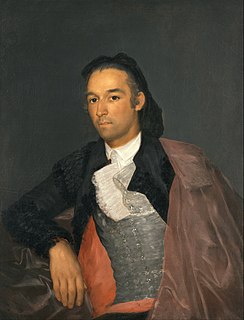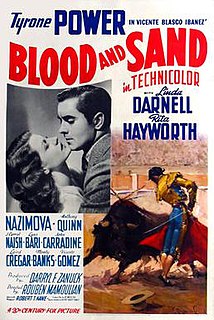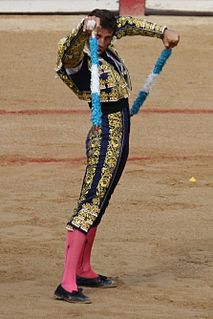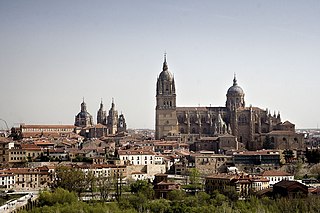Romero is a Spanish (Spain) or an Italian (Italy) surname meaning:
- A person on a religious journey or pilgrimage from Rome ; procession of elevated holy items
- The pungent botanical herb of rosemary symbolizing remembrance and fidelity
- A guardian of religious cemeteries or shrines

Manuel Benítez Pérez, more commonly known as El Cordobés, is a famous matador of the 1960s who brought an unorthodox acrobatic and theatrical style to the bullring.

The plaza de toros de Las Ventas is a famous bullring located in Madrid, Spain.

Francisco Romero López, is a Spanish bullfighter, known as Curro Romero. Born in Camas, near Seville.

Pedro Romero Martínez was a legendary bullfighter from the Romero family in Ronda, Spain.

A bullring is an arena where bullfighting is performed. Bullrings are often associated with the Iberian Peninsula, but they can also be found through Iberian America. Bullrings are often historic and culturally significant centres that bear many structural similarities to the Roman amphitheatre.
The Plaza de Toros de Ronda arena has a diameter of 66 metres (217 ft), surrounded by a passage formed by two rings of stone. There are two layers of seating, each with five raised rows and 136 pillars that make up 68 arches. The Royal Box has a sloping roof covered in Arabic tiles. The design of the main entrance to the bull ring features two Tuscan columns and the royal shield of Spain surround by baroque edging. The main door is large enough to allow horses and carriages to enter the ring, and above the door is an iron wrought balcony that embodies the bullfighting culture.
Francisco Romero (1700–1763) was a significant Spanish matador. He reputedly introduced the famous red cape (muleta) into bullfighting in around 1726.
Antonio Ordóñez Araujo (1932–1998) was a famous Spanish bullfighter.

Blood and Sand (1941) is a romantic melodrama Technicolor film directed by Rouben Mamoulian, produced by 20th Century Fox, and starring Tyrone Power, Linda Darnell, Rita Hayworth, and Alla Nazimova. It is based on the 1908 Spanish novel which was critical of bullfighting, Blood and Sand, by Vicente Blasco Ibáñez. The supporting cast features Anthony Quinn, Lynn Bari, Laird Cregar, J. Carrol Naish, John Carradine and George Reeves.

El Fandi is statistically one of the most skilled matadors in the world. Currently, he is ranked number one among all bullfighters in Spain.
Jaime Bravo was a Mexican matador during the 1950s and 1960s. Bravo was known for his death-defying style and numerous relationships with various women and Hollywood starlets.

Antonio Cayetano Rivera Ordóñez is a Spanish torero or 'bullfighter'.
Afternoon of the Bulls is a 1956 Spanish drama film directed by Ladislao Vajda. It was entered into the 1956 Cannes Film Festival. The film was selected as the Spanish entry for the Best Foreign Language Film at the 29th Academy Awards.

Bullfighting is a physical contest that involves humans and animals attempting to publicly subdue, immobilise, or kill a bull, usually according to a set of rules, guidelines, or cultural expectations. There are many different forms and varieties in various locations around the world. Some forms involve dancing around or over a cow or bull, or attempting to grasp an object from the animal.

A Miura bull is a Spanish fighting bull bred from the lineage of the Miura Cattle Ranch, located in the province of Seville, Spain. The ranch is known for producing large and difficult fighting bulls. A Miura bull debuted in Madrid on April 30, 1849.

Fiesta is an American Technicolor musical-drama film released by Metro-Goldwyn-Mayer in 1947, starring Esther Williams, Ricardo Montalbán, Mary Astor and Cyd Charisse. The film was directed by Richard Thorpe and written by George Bruce and Lester Cole.
José Humberto Eslava "Pepe" Cáceres was a Colombian bullfighter. Born in Honda, Tolima, Colombia, he is often regarded as one of the finest bullfighters ever and the best-known bullfighter Colombia has ever produced. He was also a breeder of bulls and bullfighting organizer.

Juan José Padilla is a Spanish torero ('bullfighter'). He became a matador de toros, 'killer of (full-grown) bulls', in the town of his birth, Jerez de la Frontera, on June 18, 1994 when he was 21 years old. He was known as the 'Cyclone of Jerez' and featured heavily, both personally and professionally, in Into The Arena: The World Of The Spanish Bullfight, a shortlisted nominee for the William Hill Sports Book of the Year in 2011.
Blood in the Bullring is a 1969 Spanish drama film directed by Rafael Gil and starring Alberto Closas, Ángel Teruel and Francisco Rabal.















